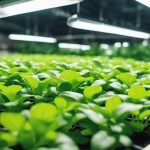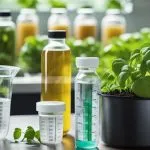Nutrient burn is a common obstacle you might face when diving into the world of hydroponics. It occurs when plants are fed too many nutrients, leading to telltale signs of distress like the tips of the leaves turning brown and crispy. In hydroponics, where you have direct control over feeding, it can be tempting to give your plants that extra bit of ‘food’ with the best intentions. But just like over-fertilizing soil-grown plants, too much of a good thing in hydroponics can lead to nutrient toxicity. This is why learning how to fix nutrient burn in hydroponics is essential.

Understanding the delicate balance of nutrient solutions is key to maintaining the health of your hydroponic plants. Recognizing early signs of nutrient burn, such as yellowing or browning leaves and stunted growth, is crucial to remedying the issue before it escalates. Identifying and fixing nutrient burn not only saves your current crop but also elevates your hydroponic gardening skills for future projects.
Addressing nutrient burn involves careful adjustment of your feeding regimen and ensuring your plants are able to recover and thrive. It’s all about providing the optimal conditions for growth, which sometimes means stepping back and allowing your plants to tell you what they need. With a watchful eye and a thoughtful approach, you can correct nutrient burn, leading to a healthy and bountiful hydroponic garden.
What is Plant Nutrient Burn?
In hydroponics, nutrient burn is an unfortunate but common problem where your plants get damaged due to excess nutrients. When you feed your plants more than they can absorb, the toxic levels of nutrients can lead to telltale signs of distress.
Severe nutrient burn in hydroponics is particularly problematic because it can lead to a significant setback in growth, or in the worst cases, the death of your plants. This is because the roots, which are constantly submerged in the nutrient solution, can’t escape the high concentration of minerals.
Here’s what happens: The roots absorb the nutrients, but when there’s too much, they can’t process it all. The unabsorbed minerals accumulate and start to affect the plant’s physiological processes, often beginning at the tip of the leaves.
If you encounter this problem, don’t worry – it can be fixed with the right approach, such as flushing your system with clean water or adjusting your nutrient solution. Remember, prevention is crucial, so always monitor your nutrient levels closely in your hydroponic setup!
What Does Nutrient Burn Look Like?
In your hydroponic garden, nutrient burn manifests with distinct symptoms on your plants, often confused with other issues. Recognizing these signs early can help you to mitigate damage and keep your plants healthy.
Early Warning Signs
Your plants will display early warning signs of nutrient burn that you should be vigilant for. The tips of the leaves might start to turn a light yellow or show a yellowish halo, which is the plant’s initial reaction to excess nutrients.
Assessing Plant Symptoms
As nutrient burn progresses, the symptoms become more pronounced. You’ll notice the yellowing of the tips expanding, becoming browned and crispy. This typically extends from the tips inward toward the rest of the leaf, indicating an increase in severity.
Another sign is the rest of the leaf becoming dark green, either completely or in patches.
Light Burn vs. Nutrient Burn
It’s essential to differentiate between light burn and nutrient burn, as they can appear similar. Light burn typically affects the areas of the plant receiving the most light, lacking the burnt tips characteristic of nutrient burn.
Is it Nutrient Burn or Deficiency?
Determining if your plants are suffering from nutrient burn or a deficiency can be tricky. Nutrient burn presents with browning and curling of leaf tips, while a deficiency might cause widespread yellowing, stunt growth, or spot formations.
Understanding the Causes
When tackling nutrient burn in your hydroponic system, it’s essential to pinpoint the root causes to implement the right solutions. Nutrient burn, commonly known as nute burn, can largely be attributed to providing your plants with more nutrients than they can absorb.
Common Causes of Nutrient Burn
Overfeeding is the most straightforward cause of nutrient burn. It occurs when plants receive a higher concentration of nutrients than they require. This overabundance can be harmful, leading to the telltale signs of nute burn.
To avoid overfeed issues, it’s important to follow a nutrient schedule tailored to your plants’ specific stage of growth. This schedule accounts for the varying nutrient requirements during different phases of development. Even with a well-chosen fertilizer, too much can overwhelm your plants, so precision is key.
Factors Contributing to Nutrient Excess
Several factors can contribute to an excess of nutrients in hydroponic systems:
- Improper mixing of nutrient solutions: Not all nutrients are created equal, and mixing nutrients in incorrect ratios or the wrong order can lead to a toxic buildup. Learn about what nutrients are in hydroponics and what roles each play.
- pH imbalances: If your nutrient solution’s pH is too low or too high, your plants may not be able to uptake nutrients efficiently, leading to accumulation.
- Poor water quality: Using unfiltered or hard water can introduce additional minerals into your system, inadvertently increasing the nutrient concentration.
By understanding these causes and factors, you can begin to take the necessary steps to restore balance to your hydroponic garden and ensure the health and productivity of your plants. Remember, moderation is crucial when it comes to nutrients, and your plants will thrive with just the right amount.
Preventing Nutrient Burn
To keep your hydroponic garden thriving, it’s crucial to prevent nutrient burn, a common yet avoidable issue. Careful monitoring and correct nutrient application are key to ensuring your plants’ health and vitality.
Proper Feeding Practices
When it comes to feeding your plants, establishing a consistent feeding schedule is essential. Stick to a routine that meets your plants’ specific nutrient demands, which can vary depending on their growth stage. Using ph-balanced water is also crucial as it allows for optimal nutrient uptake and prevents the imbalance that can lead to nutrient burn.
- Create a Feeding Schedule:
- Begin with a weaker nutrient solution and gradually increase strength as plants grow.
- Avoid feeding too frequently to prevent nutrient buildup.
- Use pH-Balanced Water:
- Check pH levels regularly; aim for a range of 5.5 to 6.5 for most plants.
- Adjust pH carefully using specialized solutions if necessary.
Monitoring and Adjusting Nutrient Levels
Regularly keeping an eye on the nutrient levels in your hydroponic system cannot be overstated. Adjusting nutrient concentration based on what your plants tell you is crucial—look for signs of both deficiency and excess to guide you.
- Mixing Nutrients:
- Follow the manufacturer’s recommendations when mixing nutrients, as overconcentration can harm your plants.
- Dilute bottled nutrients carefully, measuring doses with precision.
- Adjusting Nutrient Concentration:
- Use TDS (Total Dissolved Solids) meters to monitor nutrient concentration.
- Reduce nutrient strength if you notice signs of stress, such as tip burn or dark leaves.
Remember, when adjusting any levels, to make changes incrementally to avoid shocking your plants. Your hydroponic garden will respond better to gradual adjustments rather than sudden shifts.
How to Treat Nutrient Burn
If your hydroponic plants are showing signs of nutrient burn, quick and correct action is essential. The treatment involves reducing nutrient concentration and caring for damaged foliage to restore plant health.
Immediate Steps for Nutrient Burn Recovery
Initially, stop supplying your plants with the current nutrient solution. Perform a full system flush with pH-balanced water to eliminate excess nutrients from the root zone. Monitor your plants closely in the following days, and you may notice an improvement in their condition as they recover from the nutrient overdose.
Related: You may find that instead of nutrient burn, your plants are experiencing nutrient lockout. If that’s the case, then learn the appropriate hydroponic nutrient lockout treatment.
Long-Term Recovery Strategies
Once the immediate threat has subsided, adjust your nutrient solution to a more suitable concentration. Use EC or TDS meters to ensure that the nutrient levels are within the optimal range for your plants. Integrate a regular flushing routine into your feeding schedule to prevent future buildup of excess nutrients.
How to Fix Nutrient Burn During Flowering
During the flowering stage, plants are particularly sensitive to nutrients. To fix nutrient burn at this phase, reduce nutrient strength by around 50% and carefully inspect your plants for signs of recovery or further distress. If the condition persists, progressively lower the nutrient concentration in small increments until the plant’s health stabilizes.
Optimizing Hydroponic Health
In your hydroponic garden, achieving the delicate balance of nutrients is key to preventing issues such as nutrient burn. This balance is essential for the health and productivity of your plants throughout their lifecycle.
Monitoring System Parameters
To maintain an optimal environment for your plants, closely monitor your hydroponic system’s pH, electrical conductivity (EC), and nutrient concentration. These parameters directly influence your plants’ ability to absorb nutrients. Ideally, the pH should be between 5.5 and 6.5, and you should measure it regularly using a reliable pH meter. The EC value reveals the salt concentration in the nutrient solution, which corresponds to the nutrient strength. Regular monitoring can help you to catch any deviations early and adjust accordingly to prevent nutrient burn. Keeping a log of your readings can aid in identifying trends and making proactive adjustments.
Adjusting for Plant Growth Stages
Your plants’ nutrient requirements change as they progress through the vegetative and flowering stages. During the vegetative stage, plants generally need higher levels of nitrogen to support leaf and stem growth. In contrast, the flowering stage demands more phosphorus and potassium to develop healthy blooms and fruits.
- Vegetative Stage:
- Increase nitrogen levels
- Monitor growth patterns
- Adjust nutrient solution accordingly
- Flowering Stage:
- Boost phosphorus and potassium
- Reduce nitrogen concentration
- Taper nutrient strength as harvest approaches
By understanding and responding to these distinct needs, you can tailor your feeding schedule and nutrient concentrations, promoting robust health and avoiding the pitfalls of over- or under-feeding. Remember to adjust your nutrient mix gradually and observe how your plants respond, ensuring they always receive the right nutrition at the right time.
Related: Learn how to add nitrogen to hydroponics.
Frequently Asked Questions
Understanding how to maintain the health of your hydroponic plants is essential. Here are some common questions you might have about diagnosing and treating nutrient burn in hydroponics.






